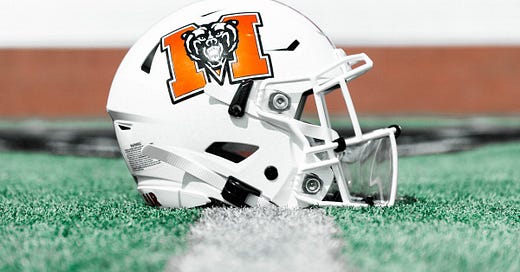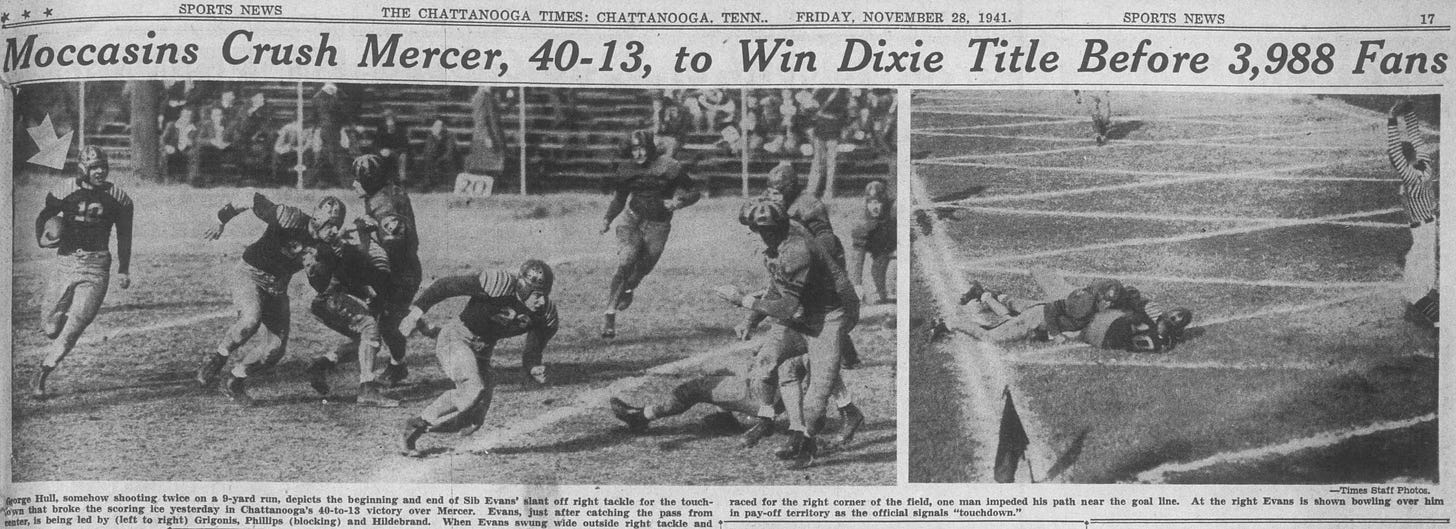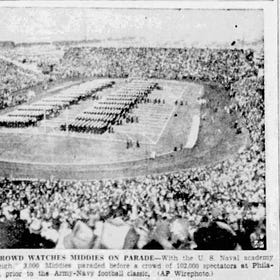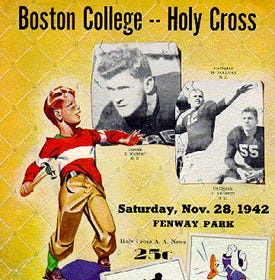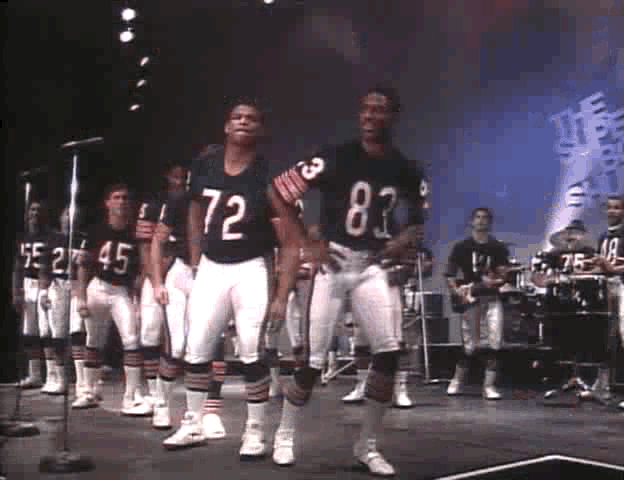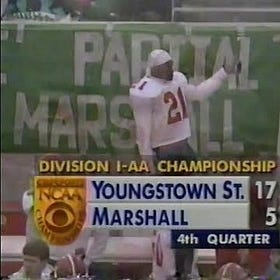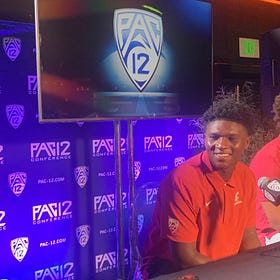Option Offense, '85 Bears Defense & Georgia National Championships: On The Mercer Football Comeback Story
Once a footnote in college football lore, the Mercer Bears are unlikely winners with unique influence on the present and the past.
Bobby Hooks was a helluva player for the Georgia Bulldogs in the Roarin’ ‘20s, starring on a team that beat perennial powerhouse Yale in 1927. Hooks’ pass to Frank Dudley set up a critical Georgia touchdown to secure the win, which became the linchpin for the second of four unclaimed national championships in the program's history.
Hooks’ foray into head coaching was less spectacular.
His lone season as a college head coach, in 1941 at Mercer University, ended on a four-game skid. Mercer suffered losses of 27-19 to Mississippi College, 32-13 against Newberry, 27-6 to Howard College (the present-day Samford), and, on Nov. 27, 40-13 to Dixie Conference champion Chattanooga.
The loss to Chattanooga was the last time a Mercer football team took the field for 72 years. In that Thanksgiving Day edition of the Johnson City Press, the game is cited as part of a column solemnly celebrating the holiday at a time of great global strife.
Less than two weeks later, Japan’s bombing of Pearl Harbor officially entered the United States into what became World War II.
College football continued during the war. The overwhelming enlistment numbers resulted in military bases fielding teams, making a powerhouse of Army West Point.
Party Like It's 1945: An Army-Navy Game for the History Books? It's Possible
Without the aid of Google, Siri or any other search function, can you name the program with the longest winning streak in the Football Bowl Subdivision?
Plenty of programs unaffiliated with the Armed Forces played on—including Bobby Hooks’ alma mater, Georgia, which won its first claimed national championship one year after the disappointing end to Hooks’ brief coaching tenure at Mercer.
The Greatest Days in College Football History: Upsets and Tragedy on Nov. 28, 1942
Less than a full year before the conclusion of the 1942 college football season, America fundamentally changed. The Empire of Japan’s attack of Pearl Harbor forced the United States into growing global conflict and commencing the second World War.
But smaller colleges and universities could not maintain the numbers and lacked the resources necessary to host varsity football. Count Mercer among the dozens of schools that shuttered football in the decade between America’s involvement in World War II and the following decade’s Korean War.
That Mercer’s first season without a program since the program launched 50 years earlier paralleled Georgia winning its first claimed national title is an interesting coincidence. The first college football game ever played in the Peachtree State pitted the private school against the University of Georgia.
The Bulldogs rolled in the 1892 matchup, 50-0, setting a precedent for SEC programs scheduling Southern Conference opponents. From there, Georgia grew into a driving force establishing football as a pillar of the Southern collegiate identity.
When Bobby Hooks and the Bulldogs beat Yale in 1927, it was among the milestone moments shifting football’s power balance from the Ivy League to the South. Almost a century later, the Mercer University Bears are fresh from their own significant win over an Ivy League opponent.
Now, if you’re reading The Press Break, you probably don’t need me to explicitly tell you that Ivy League football in the 2020s isn’t on the same tier of the national landscape as 1920s Ivy League football. The Ivies long ago transitioned from contending for championships at the top level to abstaining from playing for the Championship Subdivision title altogether.
Still, the Ivies field some quality teams with players who regularly get a look from the NFL. I recently wrote a San Diego Union-Tribune feature on a transfer from Princeton, linebacker Ozzie Nicholas, who is making a huge impression for a 5-1 Duke team. The Princeton program from which he transferred was on the wrong end of a 34-7 rout at Mercer in Week 7.
The Bears moved to 6-0 with the win, leaving them the only undefeated Div. I team in the state of Georgia. Mercer’s perfect first half of the 2024 slate includes a bit of revenge for Thanksgiving 1941, courtesy of a 10-3 defeat of Chattanooga, currently ranked No. 19 in the FCS STATS Top 25.
Mercer, for its part, is ranked No. 7. While that’s not quite up to where I had them on my ballot last week at sixth, it’s still the best ranking in program history. It’s hardly impossible, and may even be likely, that Mercer is still perfect and ranked in the top three by the time it visits Alabama on Nov. 16.
Credit a defense that embodies the long-touted Southern ideal of how Big Boy Football should be played. Mercer’s 7.7-point per game yield is the lowest in the FCS and second among all Div. I programs, behind AP Top 25 No. 1-ranked Texas’ 6.3.
There hasn’t been a group of Bears playing on that side of the ball as feisty or as well-rounded since that bunch in Chicago shuffled its way to a Super Bowl.
The unit includes cornerback TJ Moore, whose three interceptions against Princeton give him an FCS-leading five for the season.
Lineman Andrew Zock’s four sacks lead six Bears with at least two through six games, and his 6.5 tackles for loss are tops among a defense ranked sixth nationally with 46 in total.
Mercer’s offense has dealt with injuries and assorted moving parts, beginning last offseason with the transfer of dual-threat quarterback Carter Peevy to Maine. Peevy was a standout in leading Mercer to its first-ever FCS Playoffs, scoring 11 touchdowns through the air and another 12 rushing.
Finding his replacement hasn’t been smooth; three quarterbacks have been behind center through the Bears’ 6-0 start, but freshman Whitt Newbauer “added that spark,” that Mercer coach Mike Jacobs said the team needed against Princeton.
Jacobs, meanwhile, is in his first season as Mercer’s third head coach since its restart. He’s following in what’s become an influential lineage in a very short time.
When Mercer University relaunched football — a decision announced in 2010 with the restart season in 2013 — it hired Bobby Lamb to lay the foundation. Lamb was a fixture at Mercer’s current SoCon rival Furman, first as quarterback of some outstanding Paladins teams in the 1980s then as both an assistant and head coach.
Lamb’s tenure as head coach produced four FCS Playoffs appearances and a run to the semifinals in 2005. Since his time at Mercer, Lamb has been responsible for the launch of another program in the South, leading Anderson State in its first year of Div. II competition.
To lay the base for two programs in a decade is a remarkable feat, and when Lamb was tabbed to do so, he came to a Mercer program originally set for membership in the Pioneer Football League.
For those unaware, the PFL is a non-scholarship league. That’s not intended to dismiss its member programs, which include the University of San Diego. Jim Harbaugh held his first head-coaching post at USD with a staff that included David Shaw and that featured longtime NFL quarterback Josh Johnson.
But the Pioneer League is a considerable ways off competitively from the SoCon. And Mercer’s transition to winning football in the SoCon has been a road with some turns that are also influencing the current FBS scene.
The SoCon was once the gold standard for FCS football, featuring multiple dynasties with Erk Russell’s Georgia Southern teams of the late ‘80s and early ‘90s; the Marshall teams that feuded with Jim Tressel and Youngstown State for I-AA supremacy; Georgia Southern again under Paul Johnson; and the Appalachian State three-peat teams that commanded the spotlight with the 2007 upset of Michigan.
The Championship Rivalry That Helped Shape 21st Century College Football
Four teams remain in the FCS Playoffs with the semifinals this weekend, and for the first time in more than a decade, not one is North Dakota State.
None of those programs are SoCon members today, nor are any still in the FCS. And, with Georgia Southern’s move last decade, the SoCon needed to replenish its numbers. Mercer was an obvious choice, having already been in the league for other sports — including basketball, where the Bears upset Duke in the 1st Round of the NCAA Tournament the same academic year in which Mercer football returned.
But while Mercer football joined a SoCon without subdivision juggernauts Appalachian State, Georgia Southern or Marshall, the SoCon was still a damn good conference.
In the first few years after adding Mercer football in 2014, SoCon high points included The Citadel beating South Carolina in 2015. Employing a wide-open passing attack adapted from Valdosta State — a program that’s effectively been the White Tree of Gondor for air-raid offenses — Samford put together a run of playoff teams in the 2010s.
Wofford also enjoyed its best run in program history during the 2010s, winning at least eight games in seven seasons from 2010 through 2019. Under long-time coach Mike Ayers, the Terriers employed a take on the old-school triple-option offense for much of that stretch.
When Ayers retired following the 2017 season, Wofford brought in former Pitt defensive coordinator Josh Conklin — who introduced a new offense. Now, option offenses and the SoCon have a lot of history with Russell and Johnson’s respective national championship tenures at Georgia Southern.
Georgia Southern famously catered when Brian VanGorder came in during the 2000s with a new staff that showed contempt for the offense. Likewise, Wofford nose-dived when it deviated from the option after Ayers’ retirement.
The concerns athletic administrators have about tethering their football programs to traditional option offenses are not unfounded. It is a basic approach that limits the talent pool from which a team can recruit. Even those high school players who come through prep teams that run option-based or similar systems look to get out of them when they can.
Just ask Heisman Trophy candidate Cam Ward.
From Wing-T to Air Raid, Former FCS Star Cameron Ward Makes Another Remarkable Move
LOS ANGELES — Wing-T offense is about as much of an antithesis to the air raid as one could imagine, yet the former promises to influence the latter for Washington State in the coming season.
And, indeed, even the most famous option-running programs in college football have pivoted away from the decades-old flexbone approach for something more modernized. Army and Navy have both integrated new wrinkles into their offenses, and each are ranked in the AP Top 25 as of the Oct. 14 poll.
As for Mercer’s influence, first-year Navy offensive coordinator Drew Cronic came to Annapolis by way of Macon.
Cronic followed Lamb as Mercer head coach, bringing to the fledgling program a variation of the option that blended old with new. Here’s none other than Nick Saban ahead of Alabama’s matchup with the Bears in 2021 describing Cronic’s scheme:
“The easiest way to categorize it would be there’s a lot of three back runs, even though it isn't what people would recognize as the wishbone. Between the motions and so forth you know it's kind of a combination of running three back type runs that are not in spread out formations.
“There are a lot of bunch formations, and there's a lot of motions and adjustments that players have to make. So this is totally unique to anything that we’ve played against and will play against the rest of the season."
With Cronic at the controls, Navy ranks second nationally in rushing offense employing the “unique” approach to an option-based attack he introduced at Mercer.
Although his successor at Mercer and the Bears third head coach of the restart came from the same place — both Cronic and Mike Jacobs were previously at Lenoir-Rhyne — this year’s team has a different look offensively.
Offensive coordinator Anthony Soto came with Jacobs from Lenoir-Rhyne, which boasted one of the most productive and balanced attacks in Div. II football a season ago. That included frequent use of a single running back lined up with a quarterback in the Pistol. At both L-R and Mercer, it’s Dwayne McGee, a hard-charging powerhouse who led D-II in rushing in 2022.
But while the 2024 Bears run more of a spread look than a season ago, Mercer’s offense is still plenty innovative. Look no further than the use of a hook-and-lateral in the red zone to score a touchdown against The Citadel.
Through the combination of innovative offense that pays homage to what worked in the SoCon previously, and the kind of defense that SEC coordinators dream of fielding, Mercer has the potential to do something truly special in 2024.
While the SoCon has been a good conference since losing Appalachian State and Georgia Southern, the MVFC long ago became the preeminent FCS league. Both the Big Sky and Coastal have been stronger more consistently for the past decade.
And, indeed, no SoCon representative has appeared in the National Championship Game since well before Mercer joined the league. In fact, Appalachian State’s 2007 title that marked the last SoCon appearance in the final round, was three full years before Mercer brass announced the program’s relaunch.
Might the upstart Bears be the team to end the drought? Breaking into the top two of the poll will be critical, as it presumably means avoiding a long (and cold) trip into MVFC or Big Sky Country on the road to Frisco, Texas.
That it’s even a possibility is a remarkable testament to how far this program has come in such a short time since restarting.
Should the Bears emerge as national championship contenders for the FCS in the same vein as the Georgia Bulldogs on the FBS side? Well, ol’ Bobby Hooks will have twice the reason to smile from wherever he is.

